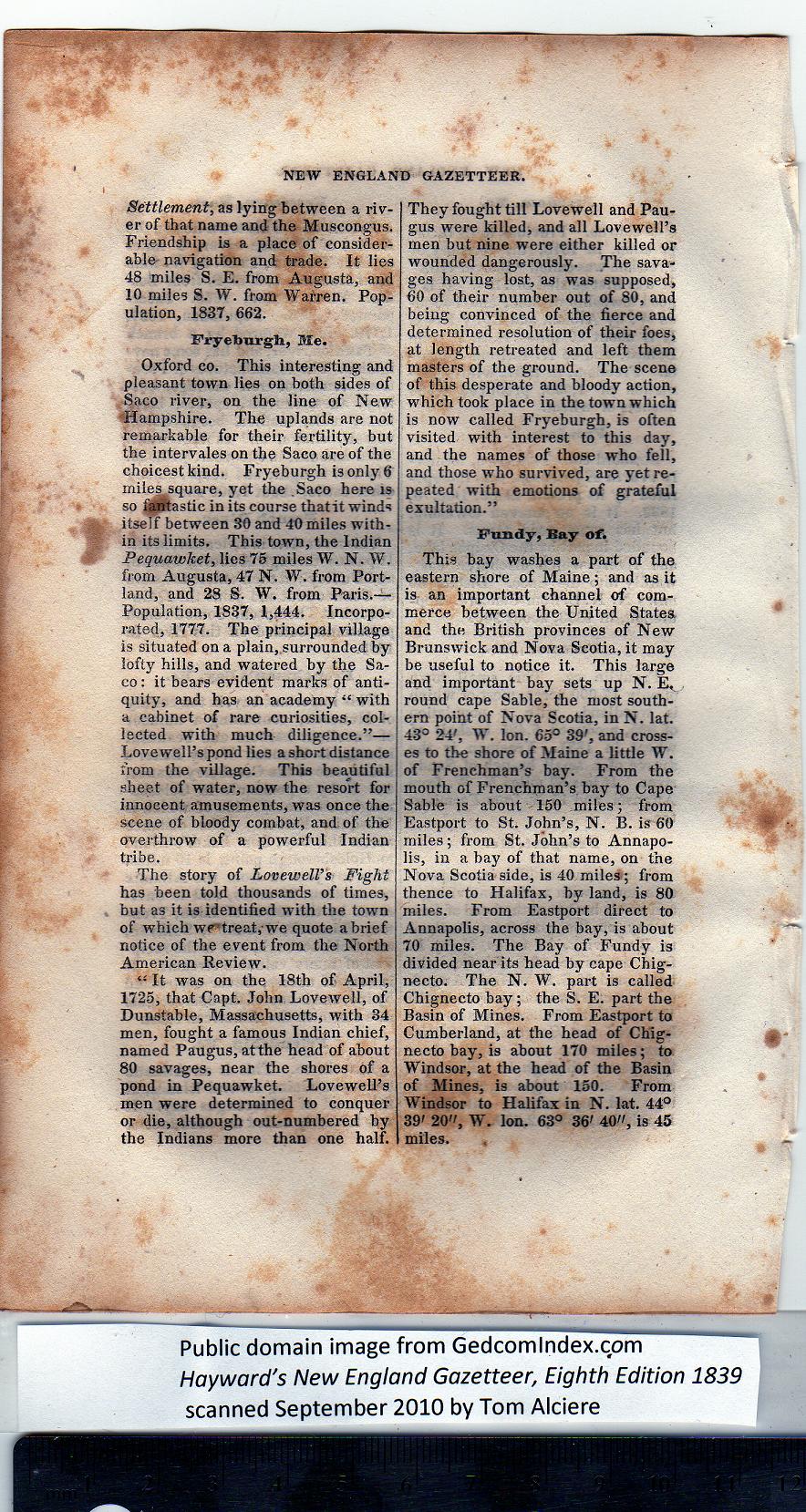|
Settlement, as lying between a riv-
er of that name and the Muscongus.
Friendship is a place of consider-
able navigation and trade. It lies
48 miles S. E. from Augusta, and
10 miles S. W. from Warren. Pop-
ulation, 1837, 662.
Fryebnrgli, Me.
Oxford co. This interesting and
pleasant town lies on both sides of
Saco river, on the line of New
Hampshire. The uplands are not
remarkable for their fertility, but
the intervales on the Saco are of the
choicest kind. Fryeburgh is only 6
miles square, yet the .Saco here is
so ijgjfcastie in its course thatit winds
itself between 30 and 40 miles with-
in its limits. This town, the Indian
Pequawket, lies 75 miles W. N. W.
from Augusta, 47 N. W. from Port-
land, and 28 S. W. from Paris.—
Population, 1S37, 1,444. Incorpo-
rated, 1777. The principal village
is situated on a plain, surrounded by
lofty hills, and watered by the Sa-
co : it bears evident marks of anti-
quity, and has an academy “ with
a cabinet of rare curiosities, col-
lected with much diligence.”—
Love well’s pond lies a short distance
from the village. This beautiful
sheet of water, now the resort for
innocent amusements, was once the
scene of bloody combat, and of the
overthrow of a powerful Indian
tribe.
The story of Lovewell9 8 Fight
has been told thousands of times,
but as it is identified with the town
of which wr treat; we quote a brief
notice of the event from the North
American Review.
“ It was on the 18th of April,
1725, that Capt. John Lovewell, of
Dunstable, Massachusetts, with 34
men, fought a famous Indian chief,
named Paugus, at the head of about
80 savages, near the shores of a
pond in Pequawket. Lovewell’s
men were determined to conquer
or die, although out-numbered by
the Indians more than one half. |
They fought till Lovewell and Pau-
gus were killed, and all Lovewell’s
men but nine were either killed or
wounded dangerously. The sava-
ges having lost, as was supposed,
60 of their number out of 80, and
being convinced of the fierce and
determined resolution of their foes,
at length retreated and left them
masters of the ground. The scene
of this desperate and bloody action,
which took place in the town which
is now called Fryeburgh, is often
visited with interest to this day,
and the names of those who fell,
and those who survived, are yet re-
peated with emotions of grateful
exultation.”
Pundy, Bay of.
This bay washes a part of the
eastern shore of Maine; and as it
is an important channel of com-
merce between the United States
and the British provinces of New
Brunswick and Nova Scotia, it may
be useful to notice it. This large
and important bay sets up N.
round cape Sable, the most south-
ern point of Nova Scotia, in N. lat.
43° 24', W. Ion. 65° 39', and cross-
es to the shore of Maine a little W.
of Frenchman’s bay. From the
mouth of Frenchman’s bay to Cape
Sable is about 150 miles; from
Eastport to St. John’s, N. B. is 60
miles; from St. John’s to Annapo-
lis, in a bay of that name, on the
Nova Scotia side, is 40 miles ; from
thence to Halifax, by land, is 80
miles. From Eastport direct to
Annapolis, across the bay, is about
70 miles. The Bay of Fundy is
divided near its head by cape Chig-
necto. The N. W. part is called
Chignecto bay; the S. E. part the
Basin of Mines. From Eastport to
Cumberland, at the bead of Chig-
necto bay, is about 170 miles; to
Windsor, at the head of the Basin
of Mines, is about 150. From
Windsor to Halifax in N. lat. 44°
39' 20", W. Ion. 63° 36' 40", is 45
miles. |
